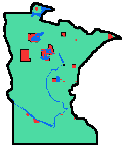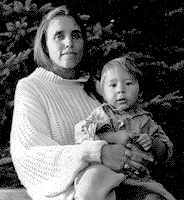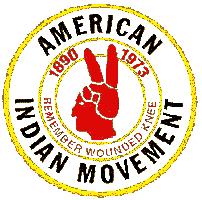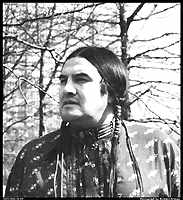Minnesota
WHITE EARTH Band of CHIPPEWA |
 |
|---|---|
|
Federally recognized
Mahnomen, Becker and Clearwater counties, Minnesota
Located in northwestern Minnesota, the White Earth reservation encompasses about 1300 square miles, but most of that land is no longer Indian-owned, due to allotment and tax forfeiture losses in the early 20th century. The reservation was established by a Treaty of March 19, 1867 with Mississippi Band Chippewa. It was going to be a sort of isolated internment camp to which all the Woodland Indians of Michigan, Wisconsin, Minnesota, and probably elsewhere were to be sent. In 1899, the Nelson Act made it law that all Chippewa Indians in Minnesota had to move to White Earth. Many refused, or looked it over and went back home to Wisconsin (or to their homes, in Minnesota). Only about 10% of the reservation land is Indian-owned. Currently the tribe is legally contesting title to all the government-owned land within the rez boundaries through WELP, White Earth Land Recovery Project, which is also attempting to protect some 1,000 burial mounds, near Ottertail (not within rez boundaries now) from desecration. (Lots of good info on the project and the rez on their newsletter page). However, the majority of the Nation's land is owned by white individuals and businesses. A tribal employee writes to an Indian-interest email list about a recent treaty rights case involving White Earth.
Until recently, better known than Winona, at least among non-Indian "spiritual seekers," was her father, Vincent LaDuke, through whom she derives her White Earth Ojibwe ancestry. In the 1960's, he took the Indian-seeming name of "Sun Bear" for himself, and did a great deal of outreach to non-Indian spiritual seekers, people with environmental concerns, and hippie drop-outs. He was much criticized for this by a white man who established a more respectable career for himself: a fake Indian who became a University of Colorado Indian Studies professor (Ward Churchill) and wrote several books that pillory alleged careerist fakes (like, but not including, himself). A large number of non-Indian "seekers" know of Sun Bear (who died in 1992). There are several websites for the continuing organizations he founded. Here's one for an organization and magazine that claims some 31,000 members, and lists dozens of books Sun Bear wrote. Sun Bear may be a controversial figure to some, but his achievements are undeniable. David Bradley (b. 1954) is probably White Earth's best-known painter at present, "He is admired as a painter's painter" (that is one who is influential and inspires other artists), says one recent encyclopedia article on Native art. As well as painting modern Indian times in both modern and traditional styles, Bradley is a founder and important thinker for the Center for the (Native American Indian) Spirit, in San Francisco, where he now lives. He was the only artist to take the top awards in both painting and sculpture at the Santa Fe Indian Market a few years ago. He was also the leading artist and spark-plug in getting a New Mexico state law passed (New Mexico operates in the largest Indian art-craft markets in the world) to protect Indian art and artists from all the fakes that were (and still are) being sold. This led to a national campaign with 1990 passage of federal law making it felony to market as "Indian" works by persons not tribally enrolled.18 USC Sec. 1159 (1993)--Misrepresentation of goods or products as by Indians This has been controversial because there are people genuinely part of Indian communities who for various reasons cannot qualify for tribal enrollments. However it is outweighed by the degree of fakery, of non-Indian artists selling fake Indian art of all media, and the imports of fake crafts from Oriental countries, that went on and still does go on. (Bradley has also been attacked in print by Prof Churchill, who -- before he somehow managed to get an enrollment certificate to the United Keetoowah Band Cherokees of Oklahoma -- was highly critical of all legal attempts to protect Indian artists via the only clear-cut criterion: National citizenship -- enrollment in a federally-recognized tribe.) Literary achievements by White Earth writers include Ignatia Broker's novel of traditional upbringing, ending with an elder (really herself) passing the knowledge to a new generation -- a little girl, but really the reader. Titled Night Flying Woman it was published by the Minnesota Historical Society, and is highly recommended. Also gaining a reputation on the national literary scene is White Earth poet Kimberly Blaeser, whose latest book of poetry, Trailing You is very briefly reviewed here. Perhaps the most difficult and demanding accomplishment by a White Earth citizen has been that of Kathleen Annette, the first Minnesota Ojibwe woman to become a medical doctor. There are still not many Native women doctors at all, the long, difficult and academically demanding courses of study tend to shunt them into lower-level health care professional education. Annette currently administers the regional Indian Health Service Office at Bemidji. She has also written an important and influential analysis on the retribalization of scattered and disheartened tribal peoples. Engineering is possibly the hardest profession for any woman to enter. Born and raised on white Earth (but I don't know her family name) is Olivia Poole, recently honored by Canadian women's engineering societies and history projects for her invention of the wildly popular Baby Jumper (sold all over the web for several hundred dollars) in the mid-1950's. She and her husband -- who were living in British Columbia -- formed a company to market it. You can read about it on this Canadian page, honoring women inventors, engineers, and for some odd reason "risk-takers". Perhaps some local relatives will be able to supply more info about her early life on the rez. Recently retired after a long and inspiring career in Indian education is White Earth member Will Antell. He served with distinction as a director and officer of the National Indian Education Association, and has held many top-level state education positions, from within which he was often able to help Indian people on reservations and in cities get better -- and less racist -- education for their young people, and sometimes even to get some state financing for it, as the non-Indian schools do.
Here's some land info compiled by the BIA regional office about mapping/computerized natural resource and environment planning data and software they have available:
White Earth Reservation
| |
 ONAP, the Office of Native American Programs of the U.S. federal Housing and Urban Development (HUD) agency has compiled some more info -- land and housing statistics and program contact names --
ONAP, the Office of Native American Programs of the U.S. federal Housing and Urban Development (HUD) agency has compiled some more info -- land and housing statistics and program contact names --  Probably the most famous White Earth tribal member at present is
Probably the most famous White Earth tribal member at present is  Probably the most widely known White Earth tribal members, for the longest time, all over the world, are the founders and highly publicized leaders of the American Indian Movement (AIM): Dennis J. Banks (who is currently working on another Run for Survival) now lives in Kenturcky, where he heads the
Probably the most widely known White Earth tribal members, for the longest time, all over the world, are the founders and highly publicized leaders of the American Indian Movement (AIM): Dennis J. Banks (who is currently working on another Run for Survival) now lives in Kenturcky, where he heads the 
 Here's a recent photo of Dennis with a Northwest Coast drum, playing at a benefit performance held August 1996 at the Indian market in Santa Fe. A much older pic shows Clyde Bellecourt taken not long after Wounded Knee in 1973. The photo actually looks more like his brother Vernon, at the time, but it's really Clyde.
Here's a recent photo of Dennis with a Northwest Coast drum, playing at a benefit performance held August 1996 at the Indian market in Santa Fe. A much older pic shows Clyde Bellecourt taken not long after Wounded Knee in 1973. The photo actually looks more like his brother Vernon, at the time, but it's really Clyde.
 Like Red Lake (and several other Minnesota tribes), White Earth issues their own license plates to tribal members. But because they do not have Red Lake's long history of rejecting all incursions of the state upon national sovereignty (they accepted Public Law 280 for instance, which forfeited tribal-federal criminal and civil jurisdiction, extending state jurisdiction over Indian Country, greatly weakening National sovereignty), they do it through the state of Minnesota. Tribal members must purchase annual update stickers from the state each year, just as everyone else must. This 92 plate shows these stickers at the right, as well as the "star of the north" design (inside an outline of Minnesota upon a tribal shield) taken as a tribal symbol.
Like Red Lake (and several other Minnesota tribes), White Earth issues their own license plates to tribal members. But because they do not have Red Lake's long history of rejecting all incursions of the state upon national sovereignty (they accepted Public Law 280 for instance, which forfeited tribal-federal criminal and civil jurisdiction, extending state jurisdiction over Indian Country, greatly weakening National sovereignty), they do it through the state of Minnesota. Tribal members must purchase annual update stickers from the state each year, just as everyone else must. This 92 plate shows these stickers at the right, as well as the "star of the north" design (inside an outline of Minnesota upon a tribal shield) taken as a tribal symbol.